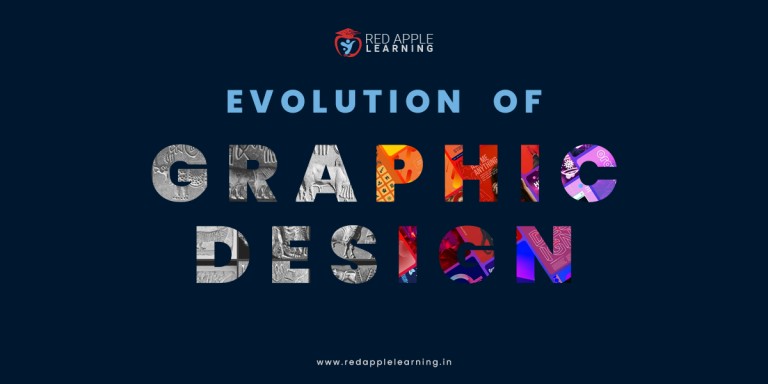Evolution of Graphic Design | Red Apple Learning
Graphic design has come a long way since its inception, evolving with the advancements in technology and the changing demands of visual communication. Graphic design, as we know it today, has a rich and fascinating history that spans thousands of years. From the earliest cave paintings to the digital age, the evolution of graphic design reflects the advancement of human communication and visual expression. In this blog, we will explore the fascinating journey of graphic design, tracing its roots, key milestones, and the impact of technology on its development. Join us as we delve into the rich history and evolution of this dynamic and creative discipline!

The Origin..!
500,000-Year-Old Shell Engraving and Pictographs (500,000 BCE – 15,000 BCE)
The roots of graphic design can be traced back to the dawn of human civilization. Evidence of early graphic design can be found in the form of shell engravings created by Homo Erectus, suggesting that even our ancient ancestors had an innate desire to express themselves visually. However, it was around 15,000 BCE that the first known visual communications emerged in the form of pictographs and symbols found in the Lascaux caves of southern France.
The Blau Monument: Early Combination of Words and Pictures
Fast-forward several millennia, and we arrive at the Blau Monument, a significant artifact from ancient times. Created sometime between 105 AD and 1530 AD, the Blau Monument is the first known artifact to combine both words and pictures. While not a sophisticated graphic design by today’s standards, this early fusion of visual and textual elements foreshadowed the possibilities of incorporating images with words, setting the stage for future advancements in graphic design.
105 AD – 1530 AD: Printing & Paper
The introduction of paper and the development of printing techniques revolutionized graphic design. In 105 AD, the Chinese invented paper, providing a more accessible medium for the creation and dissemination of visual content. The advent of printing in the 15th century, most notably with Johannes Gutenberg’s invention of the movable type printing press, led to a significant leap in graphic design. Printed materials such as books, posters, and pamphlets became more prevalent, and the art of typography and layout began to take shape.
The Industrial Revolution: 1760 – 1800
The Industrial Revolution brought about sweeping changes in society, technology, and design. With the invention of new machinery and mass production techniques, graphic design became more accessible and widespread. The rise of advertising and marketing in the 19th century demanded visually appealing designs to promote products and services. Poster art, packaging design, and typography flourished during this period, with artists and designers embracing new techniques and styles.
Growth of Graphic Design: 1900s
The 20th century marked a pivotal period in the evolution of graphic design. The emergence of modernist movements such as Art Nouveau, Bauhaus, and Art Deco brought forth new aesthetic sensibilities and design principles. Designers like Paul Rand, Saul Bass, and Milton Glaser pushed boundaries, incorporating bold colors, abstract forms, and innovative typography into their works. The advent of photography, film, and television further expanded the possibilities of visual communication, influencing graphic design across various mediums.
Click Here 👉 To Learn More About Graphic Designing Courses
Graphic Design Today: The Digital Age
In the 21st century, graphic design has become intertwined with technology, particularly with the rise of the internet and digital media. Designers now have access to powerful software tools that enable them to create and manipulate visual elements with ease. The boundaries between graphic design, web design, and user experience design have blurred, leading to a more holistic approach to visual communication.
Graphic design today encompasses a wide range of applications, including branding, advertising, user interface design, and motion graphics. Designers must not only possess a strong aesthetic sense but also understand the principles of user-centered design and accessibility. The ever-evolving nature of technology and the digital landscape continues to push the boundaries of graphic design, with new trends and techniques emerging regularly.
To Wrap Up
The evolution of graphic design is a testament to our human need for visual expression and communication. From the ancient symbols of the Lascaux caves to the digital masterpieces of today, graphic design has transformed and adapted to the changing times. As we look to the future, it is exciting to imagine how graphic design will continue to evolve, influenced by emerging technologies and cultural shifts.
